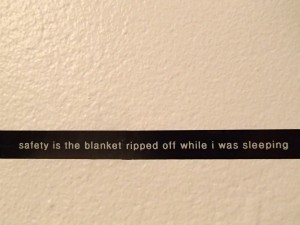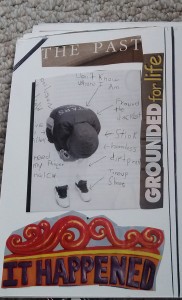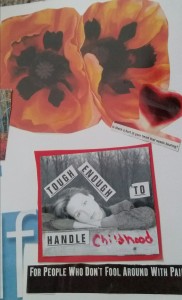“We don’t control it” said Stephen Porges about our responses to overwhelming terror nor do we control if and when old responses come up in new situations that threaten us.
This isn’t just true for trauma survivors but for survivors of life – you know – people.
We don’t control the “biological imperative to be connected to other humans” either said Porges and how necessary, healing and “regulating” human connections are.
Yet, this is complicated and difficult for those of us who have been traumatized and neglected as children by caregivers because it means we have competing needs to be near humans as well as afraid of and defensive of said humans.
Trauma disrupts ability to feel safe with another,” he said.
Sucks, right?
That’s what I say.
This is discussed in more detail in Part 1 of Polyvagal What? Stephen Porgest Fear & Trauma and Sucks Part 2 of Polyvagal What? “
Not feeling safe with others complicates a few things:
- dating
- mating
- parenting
All can be really f’n hard.
“Attachment gets ruptured,” Porges said. He spoke about how people learn patterns in early childhood that can be in evidence and seen 50-60 years later. Unfortunately, time alone won’t re-organize strategies once adaptive during traumatic stress.
If that sounds as depressing to you as it did to me, don’t fret, Porges is not without hope. He gives practical tips for creating safety below.
Simple & Profound Changes Can Go Together Even When We’re Talking Trauma
Porges gave the example of someone who as an adult suffers an MI (Myocardial Infarction). The person can understand that his/her strategy for living might have been to turn off the body. However, when that fails to be optimal for health, or maybe even life-threatening, someone can make the connection between the causes of the behavior and why to change. For more on trauma and long-term health consequences – see info. on the ACE Study.
“We can stop saying, it would be nice to down regulate my stress.” Porges, and to understand instead our patterns and how they impact health, to realize, for example, ‘I go into rage as adaptive function because I shut down. …. So I keep moving and I can’t shut down but I also can’t relate and create relationships.’
To be able to see what that body blocking shut-down causes in our health and relationships makes us better able to understand ourselves.
Survivors of developmental trauma know how hard it can be to listen to, attend to and respond to the body. This might mean just going to the bathroom quickly rather than holding it for hours and hours. It might mean resting or even napping when tired. Even that.
It means not seeing the ability to work when sick, exhausted or on empty as strength but actually for what it is – patterned self-neglect. 
These “simple” things can be eally hard. Add in DOING pro-active things such as free-writing or yoga or making healthy food choices and it might seem overwhelming. But it’s not just stupidity that makes some of us suck at self care.
It’s important to understand why and how these behaviors were started so we can be patient and compassionate while changing.
In a childhood where trauma, neglect and chaos are common children routinely have their needs not only ignored but exploited – regularly – as ‘normal’ life.
So wetting the bed and sleeping in urine-stained clothes and bedding might keep people in home away and be adaptive. But, once at school, it means ignoring the smell and shame in order to get through the teasing and a school day.
To not having sanitary supplies can make periods embarrassing and messy so ignoring the body makes it possible to ignore stains and spills and accidents. This prevents shame but also prevents being attentive to the body and self.
- being hungry or thirsty or confused might just have to be dealt with, suppressed or ignored (ignoring the body makes it possible to override rumbling belly or anxious thoughts/feelings to pay attention to traffic or in class)
- being scared while being assaulted or molested or hearing drunk parents rage or gets violent does not cause change or keep anyone safe (ignoring the body makes the fear, pain, confusion, terror and betrayal bearable)
People who haven’t been abused or neglected tend to think of abuse as isolated incidents that can simply be forgotten. However, it’s rarely about enduring a few episodes of assault a few times a week, month or year. Rather, it’s about a lifestyle where the entire family unit is ignoring basic bodily information about hunger, being clean, warm and nurtured. We learn to ignore ourselves and others too or to tune in to others only when they give signs for threat rather than say closeness or intimacy or joy.
With developmental trauma, children learn how to make chaos, neglect and f’d up stuff feel semi-normal. This might show up in adults who clean til 2 a.m. no matter how tired they are or why, as adults, some of us don’t even know how to operate unless life is busy, hectic and chaotic.
Kids in these kinds of homes get super busy, maybe stay with friends all of the time, or get super internal and listen to music and read books and hide within.
People cope in different ways but rarely is staying present with the self, sensations, the bodies or others positive, helpful or wise – AS A CHILD.
So, these behaviors of disconnecting are DEEPLY ingrained not only in habit but in our way of being in the world even when the world around us has changed dramatically. We might not even have a clue for years or decades that not everyone walks around feeling semi to totally anxious or terrified.
Understanding and respecting and having compassion for why and when and where these behaviors were learned is enormously helpful.
Porges insists that we can “recover and build new neural circuits to live a more enriched life.”
We can understand there’s biology to this (the responses to fear) and we can do some simple/profound things.”
He doesn’t leave “the things” to theory alone but gets practical.
What Helps the Body (Any Body) Feel Safe & Know It Is Safe? Stephen Porge Suggests:
- Slow deep exhalations are calming and can be done in many ways.

Photo Credit: Margaret Bellafiore
- Singing
- Playing a wind instrument
- Talking with long phrase without interruption
- Deep breathing (I like to breathe in my nose and out a straw in traffic).
- Listening to music changes middle ear muscles. Listening to music. “Listening is very special,” he said, “It’s a portal to trigger social engagement system.”Certain types of music trigger a sense of safety. Especially with female singers.”
- Talking to friend
- Talking to a dog (or cat)
- Using prosodic voice (sing song up and down)
 Porges said our nervous system evolved to detect modulations for safety and feeling Safer IS the treatment. Feeling safe can be a neural exercise as can play.
Porges said our nervous system evolved to detect modulations for safety and feeling Safer IS the treatment. Feeling safe can be a neural exercise as can play.
“FEELING SAFE IS THE TREATMENT.
That might be a way to organize your thinking” said Porges.
Isn’t that brilliant?
It’s nice to think of these actions as high level healing isn’t it? Play is another form of neural exercise. So if you are feeling safe and are involved with play you may be doing magnificent healing and that doesn’t have to be done in a therapy office. Play is healing. All of the things above, “triggers safety” and the “portal can be through breath and listening.”
Porges says that it is our nervous system that defines safety. Our nervous system says – it’s not what you say but how. Once we know biology, utilize breath through speaking to enhance vagal regulation of the heart.
Creating Safe Spaces
Porges gave great information about providing a safe space at work. He was talking specifically about clinicians treating clients but I have to think the information is true for most settings so I’ll share it here. I know it helps me think about how I want my home personal and work space.
- Space should be quiet.
- Space should have no traffic noises.
- Space shouldn’t be near elevators opening and closing.
- He mentioned looking at the masters of classic symphony who start with lullaby and violins first because classical imposers understand impact of sound. A clinician can be as intuitive. Get rid of low frequency sounds.
- Add female vocals to a space, he said, which can allow relaxation. Folk music, extraordinarily prosodic, said Porges. He noted how often folk music is in context of social change and serious issues but music is frolicky & light. This is part of tradition of folk to convey ideas without scaring people, he said.
- If person is gaze averting, don’t force eye contact. Eye gaze, when scared, isn’t comfortable. Eye gaze, while safe though, is important.
- For clinicians who can’t control factors he said, “move offices” because rooms themselves have therapeutic consequences.
- Porges said white noise machines make matters worse, not better, and that carpets and wall hangings which absorb noise are more helpful.
I don’t know about you but I haven’t spent a lot of my healing or recovery time playing, being joyful and indulging in music and what makes me feel safe, at least not in “formal healing” but intuitively I’ve done many of these things.
I love silence in the car and when writing. I love listening to music (and lots of it happens to be female vocalists) does calm and help me feel connected to myself. Free-Writing with others (doing expressive writing to a prompt topic and then sharing with others) includes lots of slow breathing, lengthy talking and listening and is the most healing practice I know. Puppies and pets and giving and receiving love – with them – well that and loving school got me through childhood!
Now, decades later, exploring healing in a way where the emphasis is less on making myself overcome being afraid and instead of changing the environment so I feel more safe is radical.
My skills at self-neglect and powering through are much stronger than my being responsive to myself and inhabiting my body regularly. 
But, that doesn’t mean I can’t and am not constantly learning. This is the fun part of recovery work. Thought it is unfamiliar still is also also interesting, rewarding and beneficial quickly.
Getting used to feeling safe is my new practice!
Further Research
- http://stephenporges.com/
- Cues of Safety/Fear https://www.youtube.com/watch?v=HiJEL6tc8jI
- Polyvagal Theory and PTSD https://www.youtube.com/watch?v=8RKC3Ga6shs
You Matter Mantras
- Trauma sucks. You don't.
- Write to express not to impress.
- It's not trauma informed if it's not informed by trauma survivors.
- Breathing isn't optional.
You Are Invited Too & To:
- Heal Write Now on Facebook
- Parenting with ACEs at the ACEsConectionNetwork
- The #FacesOfPTSD campaign.
- When I'm not post-traumatically pissed or stressed I try to Twitter, Instagram & Pinterest.
[…] Stephen Porges & Polyvagal What? Blog 1, Blog 2, Blog 3 […]